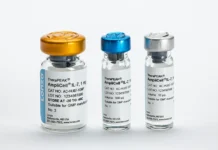Novartis AG announced that Advanced Accelerator Applications, a subsidiary of Novartis Groupe S.A., has received US FDA approval of its NDA for Lutathera® (lutetium Lu 177 dotatate*) for the treatment of somatostatin receptor positive gastroenteropancreatic neuroendocrine tumors (GEP-NETs), including foregut, midgut, and hindgut neuroendocrine tumors, in adults.
Lutathera, which received orphan drug designation from the FDA, is a first-in-class drug and the first available FDA-approved Peptide Receptor Radionuclide Therapy (PRRT), a form of treatment comprising of a targeting molecule that carries a radioactive component. The approval was based on a Phase 3 study which demonstrated a 79% reduction in the risk of disease progression or death within the Lutathera plus best standard of care arm (octreotide LAR 30mg every four weeks) compared to 60 mg of octreotide LAR alone (hazard ratio 0.21, 95% CI; 0.13-0.32; p<00.001). Novartis recently completed a successful tender offer for Advanced Accelerator Applications to become a subsidiary within the Novartis Group.
“The approval of Lutathera marks an important achievement and an innovation greatly needed for the NET cancer community,” said Susanne Schaffert, Ph.D., Chairperson and President, Advanced Accelerator Applications. “For 30 years, Novartis has supported the NET community with the development of therapeutics in NET and carcinoid syndrome. I cannot think of a better way to commemorate the joining of two organizations and our future together as we advance new nuclear medicine therapeutics in NET as well as across other tumor types.”
NETs are rare tumors originating in the neuroendocrine cells of numerous organs, including the gastrointestinal tract, pancreas and lung. Some patients develop symptoms arising from the excessive production of hormones by neuroendocrine tumor cells, while others remain clinically silent for years. The estimated incidence, or rate of new cases, of NETs in the United States is approximately 6.98/100,000 per year, while the estimated prevalence for 2014, based on the National Cancer Institute’s Surveillance, Epidemiology, and End Results (SEER) database, was 171,321.[1] Patient survival with advanced GEP-NETs depends on stage and histology. Patients with well- and moderately-differentiated tumors and distant metastases have a 5-year survival probability of 35%.[2]
The approval of Lutathera is based on results of a randomized pivotal Phase 3 study, NETTER-1 that compared treatment using Lutathera plus best standard of care (octreotide LAR 30mg every four weeks) to 60 mg of octreotide LAR, also dosed every four weeks, in patients with inoperable midgut NETs progressing under standard dose octreotide LAR treatment and overexpressing somatostatin receptors, as well as a subset of efficacy and safety data from an international, single-institution, single-arm, open-label trial conducted by Erasmus Medical Center in Rotterdam, Netherlands in more than 1,200 patients with somatostatin receptor positive tumors.
The NETTER-1 study met its primary endpoint, showing a 79% reduction in risk of disease progression or death using Lutathera compared to 60 mg octreotide LAR (hazard ratio 0.21, 95% CI: 0.13-0.32; p<0.0001).[3] Median PFS was not reached in the Lutathera arm compared to 8.5 months for the 60 mg octreotide LAR arm.[3] A pre-planned interim overall survival analysis determined that Lutathera treatment lead to a 48% reduction in the estimated risk of death (hazard ratio 0.52, 95% CI: 0.32-0.84) compared to treatment with 60 mg octreotide LAR.[3] The objective response rate, composed of complete and partial responses, was 13% for the Lutathera arm compared to 4% in the Octreotide LAR 60mg arm (p<0.0148).[3]
The most common Grade 3-4 adverse reactions occurring with a greater frequency among patients in the NETTER-1 study receiving Lutathera with octreotide compared to patients receiving high-dose octreotide include: lymphopenia (44%), increased gamma-glutamyl transferase (20%), vomiting (7%), nausea and elevated aspartate aminotransferase (5% each), and increased alanine aminotransferase, hyperglycemia and hypokalemia (4% each).[3]
Lutathera® (lutetium Lu 177 dotatate) Important Safety information[3]
INDICATION
Lutathera® is a radiolabeled somatostatin analog indicated for the treatment of somatostatin receptor-positive gastroenteropancreatic neuroendocrine tumors (GEP-NETs), including foregut, midgut and hindgut neuroendocrine tumors in adults.
WARNINGS AND PRECAUTIONS
Radiation exposure: Treatment with Lutathera contributes to a patient’s overall long-term radiation exposure and is associated with an increased risk for cancer. Radiation can be detected in the urine for up to 30 days following Lutathera administration. Minimize radiation exposure to patients, medical personnel, and household contacts during and after treatment with Lutathera consistent with institutional good radiation safety practices and patient management procedures.
Myelosuppression: Due to potential hematological adverse reactions such as anemia, thrombocytopenia, leukopenia, lymphopenia, and neutropenia, blood cell counts must be monitored prior to, during, and after treatment. Dose modification or cessation of treatment may be necessary.
Secondary Myelodysplastic Syndrome and Leukemia: With a median follow-up time of 24 months, myelodysplastic syndrome (MDS) was reported in 2.7% of patients receiving Lutathera with long-acting octreotide compared to no patients receiving high-dose long-acting octreotide. In a Phase I/II clinical study, 15 patients (1.8%) developed MDS and 4 (0.5%) developed acute leukemia. The median time to the development of MDS was 28 months (9 to 41 months) and 55 months (32 to 155 months) for acute leukemia.
Renal toxicity: Treatment with Lutathera will expose kidneys to radiation, which may impair renal function. Monitor serum creatinine and creatinine clearance to assess changes in renal function. A concomitant intravenous infusion of amino acids during Lutathera administration is mandatory for renal protection. Patients with baseline renal impairment may be at greater risk of toxicity. Perform more frequent assessments of renal function in patients with mild or moderate impairment. Withhold, reduce dose, or permanently discontinue based on severity of reaction.
Hepatotoxicity: In Lutathera clinical trials, <1% of patients were reported to have hepatic tumor hemorrhage, edema, or necrosis, with one patient experiencing intrahepatic congestion and cholestasis. Patients with hepatic metastasis may be at increased risk of hepatotoxicity due to radiation exposure. Monitor transaminases, bilirubin, and serum albumin during treatment. Withhold, reduce dose, or permanently discontinue based on severity of reaction.
Neuroendocrine hormonal crises, manifesting with flushing, diarrhea, bronchospasm and hypotension, occurred in 1% of patients and typically occurred during or within 24 hours following the initial Lutathera dose. Monitor patients for flushing, diarrhea, hypotension, bronchoconstriction or other signs and symptoms of tumor-related hormonal release. Administer intravenous somatostatin analogs, fluids, corticosteroids, and electrolytes as indicated.
Embryo-Fetal Toxicity: Lutathera can cause fetal harm. Advise females and males of reproductive potential of the potential risk to a fetus. Advise females and males of reproductive potential to use effective contraception during treatment and after. Verify pregnancy status of females of reproductive potential prior to initiating Lutathera.
Temporary Infertility: Radiation absorbed by testis and ovaries from the recommended cumulative Lutathera dose falls within the range in which temporary or permanent infertility can be expected following external beam radiotherapy.
ADVERSE REACTIONS
The most common Grade 3-4 adverse reactions observed in Lutathera clinical trials were lymphopenia (44%), increased GGT (20%), vomiting (7%), nausea (5%), elevated AST (5%), increased ALT (4%), hyperglycemia (4%), and hypokalemia (4%).
The following serious adverse reactions are rare but have been observed with a median follow-up time of more than 4 years after treatment with Lutathera: myelodysplastic syndrome (2%), acute leukemia (1%), renal failure (2%), hypotension (1%), cardiac failure (2%), myocardial infarction (1%), and neuroendocrine hormonal crisis (1%). Patients should be counseled and monitored in accordance with the Lutathera prescribing information.
DRUG INTERACTIONS
Somatostatin and its analogs competitively bind to somatostatin receptors and may interfere with the efficacy of Lutathera. Discontinue long-acting somatostatin analogs at least 4 weeks and short-acting octreotide at least 24 hours prior to each Lutathera dose. Administer short- and long-acting octreotide during Lutathera treatment as recommended.



















